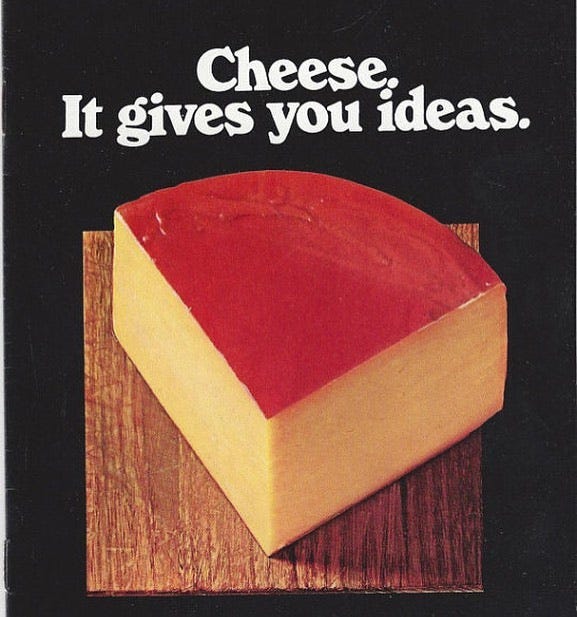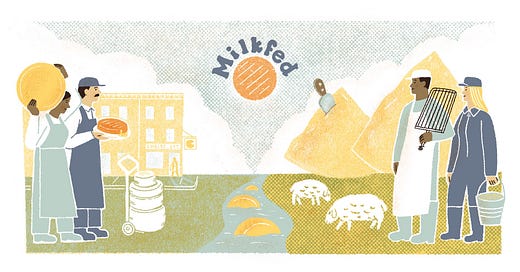How I Fell in Love With Cheese
A story, an introduction, and what to expect from this newsletter

At the height of the late-aughts locavore frenzy, I fell in love with cheese.
After a couple of years managing the cheese section at my local Trader Joe’s, I got a new job at a nonprofit community-supported agriculture program in Philadelphia. Each week, members would pick up fruit, vegetables, a protein like eggs or tofu, and a portion of cheese sourced from local creameries. I stocked fridges, hauled skids of sweet corn and pumpkins back to the truck at the weekly produce auction, replenished flats of heirloom tomatoes during pickups, and wrote the member newsletter.
On one of my first days at the urban farm, my task was to bring three enormous wheels of cheese to the church kitchen a few blocks away and break them down into a few hundred individual-sized hunks. Most of the cheeses we distributed were sourced from Amish farmers, vac-packed blocks of cheddar and Swiss styles shot through with herbs or garlic or bits of pepperoni. They were chosen for price and durability rather than flavor or variety. But this one was different.
Despite being raised on blocks of extra-sharp supermarket cheddar, I’d had “fancy” cheese before. On Christmas visits to my mother’s family in Quebec, we’d eat snowy, soft-ripened wheels with crackers and cornichons and melt ruddy slabs of raclette over baby potatoes and hunks of baguette. But these wheels were unlike any I’d ever seen.
The cheese was Cherry Grove Farm’s Toma Primavera, made only with spring milk; we were just now cracking into them in September. The broad, peachy-pink rind was tacky under my fingers and splotched with white and brown, like an old terra cotta pot left in the garden, weathered and coated in salts. The paste inside was moist and dense and hay-colored, crumbling slightly as my knife clumsily cut through.
In that hot, stuffy kitchen, the cheese’s aroma was powerful and rustic. I put a sliver on my tongue. The flavor was rich and savory, toasted nuts and fresh meadow.
If eating a Cherokee Purple tomato for the first time hinted that there was more to food than what you buy at the supermarket, this cheese, in all its boldness and uniqueness and complexity, shouted the existence of whole worlds I’d never tasted before. At that moment, the trajectory of my life shifted.
Later, I’d meet even more fascinating cheeses and cheesemakers. My next job was as a buyer at an all-local farmstand that had an all-local case with more than 50 styles of cheese produced within 150 miles of Philly. I met friends (and future collaborators) like Sue Miller of Birchrun Hills Farm, one of the first artisan makers in Pennsylvania and a tireless champion of local cheese, and Stefanie Angstadt, whose boundless energy and enthusiasm launched Valley Milkhouse, a micro-creamery that’s since grown to be the culinary heart of her community. I also met Tenaya Darlington, AKA Madame Fromage, whose passion project turned side gig showed me that one could make a career writing about cheese.
These days, I don’t do much buying or selling, though I still do a little. I mostly write about cheese, typically for businesses that sell or promote cheese and dairy products. I get to use the storytelling skills I developed as a journalist, flex my salesmanship honed over five years selling cheese at farmers’ markets, and put the knowledge I gained researching the book I wrote to good use.
In the slow-motion adrenaline rush of late March 2020, I snagged this Substack domain. I’d been thinking about a new way to publish work and interact with the cheese world—a podcast, a newsletter, a social media account? And then nothing happened, because keeping my little household of three (two humans, one cat) alive took precedence. Then a lot of things happened—including an involuntary move and 16 months road tripping around the country in an effort to reconnect with family and stave off pandemic cabin fever.
I feel lucky to do what I do—to use the talent, skill, and expertise I’ve gained over 15 years working in cheese to earn a living. But there’s so much more to the world of cheese and dairy than is typically captured in a client brief. The conversations we have about cheese, especially on social media, tend to focus on consumption and pleasure.
Pairings, recipes, kaleidoscopic cheese boards, and scandalous cream lines may drive engagement and sales. But the enjoyment—and joy—we experience eating these foods are only part of what they offer us. I wanted to explore what often goes unmentioned, both among cheese lovers and in the cheese industry. To consider cheese and dairy in full context—historical, geographical, cultural, nutritional, environmental.

Of course, working full time while navigating nomadic life (and pitching in with housework and errands and childcare or elder care at each stop) isn’t terribly conducive to deep thinking and thoughtful writing, either. But I was still dreaming, still scheming and researching, still hoarding hundreds of tabs about biodigesters on dairy farms and Arizona wells going dry to feed Saudi Arabian cows and obscure failed oat milk products from the ’90s and also this bizarre, pun-laden video of Brett Favre and Tucker Carlson talking about cheese on Fox News.
Each of these examples shows that cheese, milk, butter, and yogurt are more than commodities we eat, buy, sell, or make. Their production can change landscapes and alter cultural foodways. They can nourish our bodies, but their marketing can reinforce the idea that our bodies will never be good enough. These foods can provide a way to signal our identities in a consumerist society, or function as banners in online culture wars.
All food tells a story. But the potential for dairy—especially cheese, which paradoxically captures a moment in place and time while constantly changing and evolving—to act as a gateway to greater understanding of the forces that have reflected and shaped human life for millennia feels ripe for exploration. I want this newsletter to be a space to think, talk and think about cheese and dairy beyond consumption. And I want you—cheesemongers, cheesemakers, dairy farmers, and eaters everywhere—to be part of that discussion, too.
Expect Milkfed in your inbox every two weeks—once I get into the swing of things, I’m hoping to post weekly as life and work allow. I’m starting with exploratory essays like this one, but I hope to incorporate reported pieces, commentary, interviews, and maybe even an audio component in the near future.
Topics I plan to tackle include history, climate, environment, labor, colonization, culture, identity, and more as they relate to dairy. And sometimes, I’ll write about that fun stuff, too: what’s in my cheese drawer, deep dives into certain cheeses or foodways, pairings I love. Because as much as I’m driven to dig in and truth-tell and write about things no one else is talking about, I love cheese as much as anyone—eating it, talking about it, writing about it.



